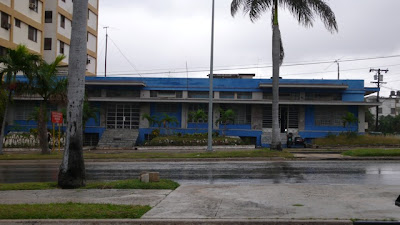Architecturally, Havana is all it's cracked up to be and more: once glorious buildings dripping with neglect; a distinct beauty of accrued patina that defines the city.
There is also a healthy dose of mid-century architecture that gets less ink than the spanish revival buildings. However, both eras are equally neglected– creating a sort of architectural duality that describes a city frozen in time.
Cuban architecture magazines from late 1958 and early 1959 give a fascinating glimpse into what was a progressive, prosperous architectural and cultural milieu.
During this time Castro would take meetings with leading architects and explain the new regime's focus on building for the social good of the people and the state rather than the glory of the architect and private clients. Translation: the slow decline of architecture in Cuba.

Cuba's national architecture magazine, #302 September 1958. Pre-revolution, the issue profiles a residence designed by Frank Martinez Justiz on the cover and in an inside story.

Arquitectura, #308 March 1959. Post-revolution, this issue focuses on architecture for the state and has an article on Castro's visit to the College of Architects.

1958 Sargeant advertisment showing the School of Engineering building at the University of Villanueva, by architect Ricardo Galbis Martinez.

1958 Gold Medal-winning residential design by Richard Neutra, Raul Alvarez and Enrique Gutierrez.

Plans for Neutra's design showing the common language with his other residential work at the time.

Original 1958 Schlage advertisment featuring the Seguro Medico building.

Seguro Medico in 2011. Balconies have been painted purple and red.











 A regional Cuban airport with the clean lines of International Style modernism, kept relatively intact.
A regional Cuban airport with the clean lines of International Style modernism, kept relatively intact.
 The classic old Havana street scene.
The classic old Havana street scene.




The Havana Libre (originally Hilton, 1958) features a massive tile wall mural by Cuban artist Amelia Pelaez (1896-1968). The hotel was designed by Los Angeles architects Welton Becket & Associates, who also designed the Capitol Records building in Hollywood.

A canopy of circular ceiling skylights in the lobby of the Havana Libre.

The Capri (1957), no longer in operation, with the FOCSA apartment building in the background, one of Havana's largest residential buildings.

Typical old Havana skyline.

Residential tower on the Malecon with shades of Corbusier.

The Habana Riviera lunchroom (above and below). Like walking into 1957.


Riviera lounge entrance (and ex-casino) with expansive wall mural by Rolando Lopez Dirube.

The pristine lobby of Habana Riviera, featuring a stunning sculpture collection. Much of the hotel has not been as well maintained.

Half a dozen oversize paintings by Cuban artist Cundo Bermudez (1914-2008) hang in the defunct lounge of the Habana Riviera, awaiting customers who will never come. These works are national treasures and sit gathering dust behind closed doors.

The half-promising front entrance to the Habana Riviera. The sculpture (by Florencia Gelabert) and scale are impressive but undercut by a tattered water feature that runs dry and speaks to the general lack of supplies and resources in Cuba.
 A regional Cuban airport with the clean lines of International Style modernism, kept relatively intact.
A regional Cuban airport with the clean lines of International Style modernism, kept relatively intact. The classic old Havana street scene.
The classic old Havana street scene.
Buildings (above and below) originally built for and still used by the Cuban film and television industry.


The National Museum of Fine Arts in Havana has an impressive collection of Cuban artwork but the dearth of any literature on Cuban artists and culture was disappointing.
Unlike other cities, Havana never progressed beyond a functional European style modernism. The architectural variants that developed and supplanted it in North America are nowhere to be found. As with everything else, the dividing line is January 1959 and one can't help but get the feeling that, after fifty years of revolution, the Cuban people are waiting for change.












No comments:
Post a Comment